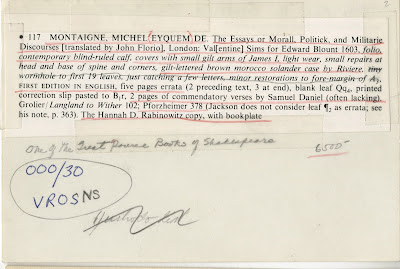One of the many jobs our collection staff handles is answering research questions from folks outside the institution. Sometimes the questions can be downright unusual–our librarian remembers fielding a call from someone asking if we had newly discovered photos of Area 51 (apparently a news site mixed up a couple of links). But oddities aside, one of the most common questions we get is from people trying to track down information about objects that were purchased or sold through the Rosenbach Company. Here’s a quick behind-the-scenes peek at some of the kinds of records we have from the Rosenbach Company that we can use to answer these questions.
 Stock cards (perhaps unsurprisingly) describe the books and manuscripts the Company had in its stock. Each represents a particular book or manuscript and the cards are organized by author or by subject. Individual cards vary, but they can include a description (often cut and paste from a Rosenbach Company sales catalog, as seen here) , stock numbers, provenance and/or sale information, and information about price. The price information is encoded using the ten letter word HOVERZACKS to represent the 10 numerals. The fine and decorative arts side of the business doesn’t have stock cards, only stock books, which are obviously trickier to use because they aren’t sortable in the way cards are. You can see the decorative arts stock book in the Inquiring Minds exhibition.
Stock cards (perhaps unsurprisingly) describe the books and manuscripts the Company had in its stock. Each represents a particular book or manuscript and the cards are organized by author or by subject. Individual cards vary, but they can include a description (often cut and paste from a Rosenbach Company sales catalog, as seen here) , stock numbers, provenance and/or sale information, and information about price. The price information is encoded using the ten letter word HOVERZACKS to represent the 10 numerals. The fine and decorative arts side of the business doesn’t have stock cards, only stock books, which are obviously trickier to use because they aren’t sortable in the way cards are. You can see the decorative arts stock book in the Inquiring Minds exhibition.
 The Rosenbach Company sales books list all the purchases that customers made from the store: art and antiques, books and manuscripts, as well as sales from the frame shop and services the Company provided. The books run chronologically; there are 29 books for the fifty years. Frame numbers and delivery numbers turn up here, as well as information about the staff members who made the sale.
The Rosenbach Company sales books list all the purchases that customers made from the store: art and antiques, books and manuscripts, as well as sales from the frame shop and services the Company provided. The books run chronologically; there are 29 books for the fifty years. Frame numbers and delivery numbers turn up here, as well as information about the staff members who made the sale.
 Any person who made a purchase at the Rosenbach Company on credit had an accounts receivable card which listed dates and amounts of debits (purchases) and credits (payments). This card is one of many from Mrs. George D. Widener which are currently on display in Titanic: The Rise of Rosenbach.
Any person who made a purchase at the Rosenbach Company on credit had an accounts receivable card which listed dates and amounts of debits (purchases) and credits (payments). This card is one of many from Mrs. George D. Widener which are currently on display in Titanic: The Rise of Rosenbach.

On the flip side from account receivable are payment vouchers, which record payments the Rosenbach Company made to its suppliers. These vouchers sometimes include invoices or receipts from book dealers, auction house, or other creditors.
There are many other types of materials that tell us about the workings of the Rosenbach Company, from sales catalogs to collation files to voucher registers, but hopefully this at least gives a glimpse into the way we tackle this research.

Kathy Haas is the Assistant Curator at the Rosenbach Museum & Library and the primary poster at the Rosen-blog
